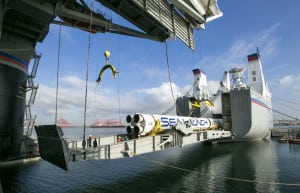Latest News
[Via Satellite 03-10-2015] Within the next couple of months Sea Launch plans to announce a big decision influencing the future of the company. Since the last launch of the Zenit 3SL rocket with the 6-ton Eutelsat 3b satellite in May 2014, there has been a gap in launch activity that put the company in a hibernation mode. Three months after the Eutelsat mission, Sea Launch placed its ships into layup and shut down the generator on the Odyssey launch platform.
Serguei Gugkaev, CEO of Sea Launch told Via Satellite that the drawdown has reduced the massive energy demand from its unique ocean-fairing vessel, and also reduced payments to hardware manufacturers. Sea Launch reduced its operations and head count globally as well — a move Gugkaev said is typical when faced with a manifest gap. Rather than sit idle, the company has been actively considering substantial changes, mainly alternative launchers and a possible major relocation.
“There are several different paths and ways where Sea Launch might go in the future, and one of these scenarios is that Sea Launch would change its launch vehicle,” said Gugkaev. “There could be scenarios where we would remain in the same operational mode as we are right now with the U.S. as our homeport for vessels and Zenit as our launch vehicle. There could be scenarios where we would be relocating Sea Launch operations from the U.S. but keeping Zenit as the rocket. Different scenarios are possible.”
One new rocket option could come from Russia’s Angara family, built by Khrunichev State Research and Production Space Center, manufacturer of the Proton rocket. Russia conducted the maiden launch of the Angara 1.2 small lift launch vehicle in July 2014, followed by a December launch demonstration of the Angara A5.1 equipped with a Breeze M upper stage. The yet-to-fly Angara A7 is designed to launch up to 12.5 tons to Geostationary Transfer Orbit (GTO).
Sea Launch has also considered creating a new iteration of the Zenit rocket, but Gugkaev said economic turbulence has made funding such developments a challenge. Sanctions on Russia following the nation’s invasion of Ukraine and the unexpected sharp downturn in global oil prices dealt a crippling blow to the ruble, limiting Sea Launch’s partner and majority owner Energia Rocket and Space Corporation (RSC Energia) from pursuing new large capital expenditures.
Today Sea Launch SA is owned by Luxembourg company Sea Launch SARL, of which RSC Energia affiliate Energia Overseas owns 95 percent. Boeing of the United States and Aker of Norway indirectly own 3.5 percent and 1.5 percent respectively.
Ukrainian rocket manufacturer Yuzhmash, which builds a significant fraction of the Zenit 3SL is also struggling with the impact of, among other conflict-driven challenges, massive inflation of the hryvnia and limited revenue opportunities due to stunted business. The explosion of Orbital Sciences’ Antares rocket in October 2014 slowed demand for that vehicle, and Sea Launch’s manifest gap has also yielded no new orders for Zenit launchers.
“They have quite a lot of financial difficulties in the time being, because I would say 80 percent of their revenues are coming from Zenit launch vehicles and Antares launch vehicles,” explained Gugkaev. “These two major sources of revenue for Yuzhmash are for the time being not bringing any money to the factory. Yuzhmash is struggling to get some governmental support, as it is 100 percent owned by the Ukrainian state, which is also in a difficult situation. It is not easy for them.”
Gugkaev said the more likely outcome for Sea Launch is a launch vehicle swap-out. The company is also actively looking into relocation closer to the equator. Now that the three nations where the company is most present are all embroiled in a complicated political web that is making business difficult, other nations could provide much needed stability.
“We have all three countries involved one way or another in these geo-political events in Ukraine. We have the U.S. as a base for our homeport and ships, we have Ukraine as a manufacturer of our launch vehicle, and we have Russia as one of the providers of hardware and also as shareholders. So it’s been a situation that affects us indirectly,” said Gugkaev.
Brazil was a rumored destination, but Gugkaev said there was interest coming from elsewhere around that latitude.
“I would not particularly focus on Brazil, but what I can say is that it is a fact that certain countries that are based not far from the equator have expressed their interest to work with Sea Launch as a unique launch system that has a lot of advantages,” he said. “We are working right now to define the best candidate for this possible relocation.”
Sea Launch’s shareholders have not come to any final decisions on rockets or relocations yet, but Gugkaev said there are many possible scenarios around the equator, including Sea Launch becoming part of a national space program, providing launch services for a nation, or even becoming part of a new joint venture. Whatever decision Sea Launch leadership makes in the coming months will have a long-term impact on the direction of the company.
Stay connected and get ahead with the leading source of industry intel!
Subscribe Now